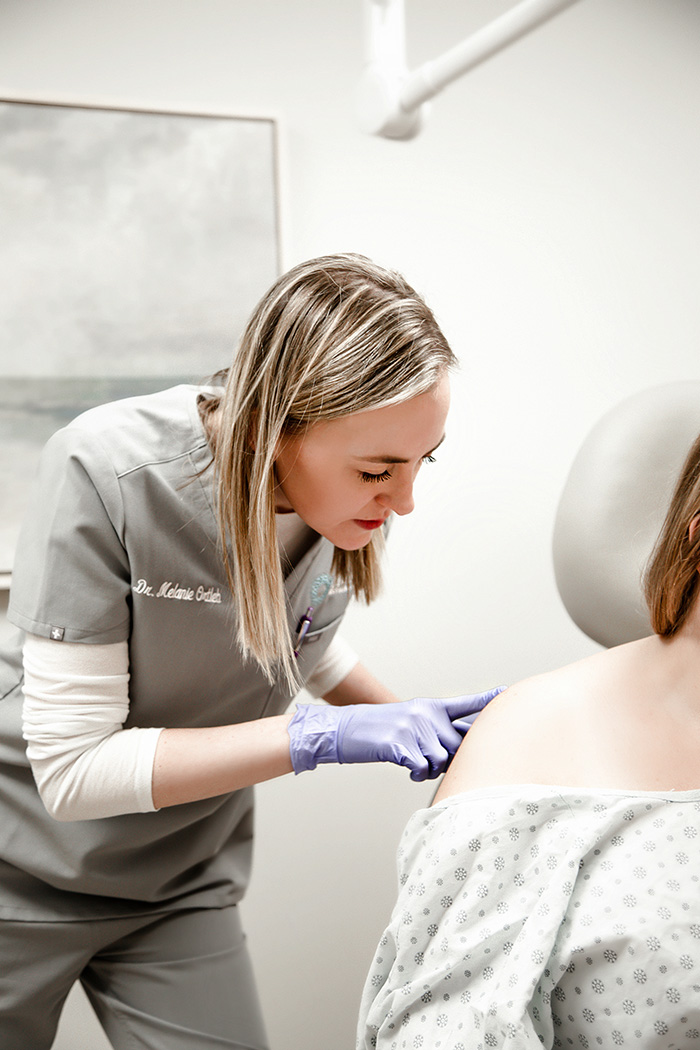DERMATITIS & SKIN RASH TREATMENT IN OMAHA
Skin rashes and dermatitis, no matter their cause, can be uncomfortable and lower confidence. Many tend to seek over-the-counter treatment options, such as hydrocortisone cream, though this approach doesn’t always work. To the untrained eye, the cause of your rash may be difficult to determine, as there are numerous types and causes of rashes—that’s why we recommend seeking the expertise of a board-certified dermatologist to help you correctly diagnose and treat your rash or dermatitis.
At MOD Dermatology, we specialize in the diagnosis and treatment of dermatitis and a variety of skin rashes at our Omaha clinic, including shingles, herpes labialis, drug eruptions, and more. Call our Omaha office today at 402-505-8777 to schedule your appointment with Dr. Melanie Ortleb or Physician Assistant Amy K. Price.

Available Skin Rash & Dermatitis Treatments
At MOD Dermatology, we have experience in dermatitis and skin rash treatment at our Omaha clinic that are caused by the following conditions:
- Cutaneous lupus, including discoid lupus, subacute cutaneous lupus, lupus panniculitis
- Bullous pemphigoid, pemphigus vulgaris, and other autoimmune blistering diseases
- Dermatomyositis
- Lichen planus
- Morphea and Scleroderma
- Graft vs. Host Disease
- Drug eruptions
- Erythema multiforme
- Stevens-Johnson Syndrome and Toxic Epidermal Necrolysis
- Shingles
- Herpes Labialis
What is Dermatitis?
Dermatitis is a general term that can refer to many types of skin rashes. Skin rashes can be caused by infections, allergies, and irritation, and can range from mild to severe. Rashes can be characterized by a number of symptoms, including itchiness, swelling, discoloration, crusting, blisters, soreness, reddening, and more.
There are different methods of dermatitis treatment at our Omaha clinic for different types of this skin rash, so it’s important to identify which kind of dermatitis you have, as well as your symptoms and triggers, so you can find the best possible treatment and management plan.
The different types of dermatitis:
Atopic dermatitis (AD), commonly referred to as eczema, typically begins during infancy or childhood, but it can affect people of any age. When children get AD within their first year of life, it often manifests as dry and scaly patches on the forehead, scalp, and cheeks. When AD begins in children between 2 years old and puberty, rashes often begin in the creases of the elbows or knees. In adults, AD often appears as darker patches of scaly skin in the creases of the elbows, knees, and nape of the neck, but can cover any area of the body.
No matter where it appears, atopic dermatitis is typically accompanied by itchiness—this can affect sleep and lead to infection due to excessive scratching. Most often, it affects people who also have asthma, a family history of eczema or asthma, or people with defects in the skin barrier.
Contact dermatitis happens when the skin comes in contact with irritating substances or allergens. This causes the skin to become inflamed, burn, itch, and become red over time. Most everyone will experience this type of dermatitis at least once in their lifetime. Sometimes contact dermatitis is caused by an allergic reaction to things like poison ivy, nickel, jewelry, makeup, latex, or adhesive. More commonly, however, contact dermatitis is caused by irritants—diaper rash, cracked knuckles, and irritated skin around the mouth are all common types of contact dermatitis.
Dyshidrotic eczema is fairly common and causes small, extremely itchy blisters on the edges of fingers, toes, palms, and soles of the feet. Dyshidrotic eczema is associated with seasonal allergies, so those with this skin condition will most likely see flare-ups during the spring and fall allergy seasons. Other common triggers of this type of eczema include stress, pollen, prolonged contact with moisture, nickel, cobalt, and chromium salts. Blisters can last weeks and can sometimes be large and painful. Although there is no cure for dyshidrotic eczema, it can be managed with the help of a dermatologist.
Nummular dermatitis is a common type of eczema that can affect people of any age. People with Nummular Dermatitis often develop itchy, coin-shaped spots on their skin that can be very difficult to treat. These coin-shaped sores can appear after an injury, such as a burn, friction abrasion, or insect bite. They can range in size from smaller than 1 inch to bigger than 4 inches, and occur most often in the legs—though they can also occur on the feet, torso, hands, and arms. Nummular dermatitis is often accompanied by itching and burning. If a yellowish crust appears on the patches, an infection may have occurred and should be evaluated as soon as possible.
Seborrheic dermatitis is considered a chronic form of dermatitis that appears on the body where there are a lot of oil-producing glands, such as the scalp. Seborrheic dermatitis can cause the skin to have a red, swollen, greasy, and white or yellowish scaly appearance. In infants, seborrheic dermatitis is commonly known as cradle cap. Adults who have seborrheic dermatitis may get flare-ups on and off for the rest of their life. Stress, cold or dry weather, and other triggers may cause a flare-up. However, there are effective treatment options for managing seborrheic dermatitis.
Stasis dermatitis occurs when there is an issue with blood flow in the veins, which can cause fluid to accumulate in tissue and subsequently cause skin irritation. Poor blood flow is most common in the lower legs. As a result, stasis dermatitis often develops in the calf, ankle, and feet. Swelling around the ankle is typically the first sign of stasis dermatitis—as the condition progresses, you may notice heaviness or aching in the legs, swelling, varicose or spider veins, dry skin, itchiness, and irritation. For those with stasis dermatitis, self-care and treatment are essential to keeping the condition under control.
Get Dermatitis and Skin Rash Treatment in Omaha
If skin rash and dermatitis are causing you to be uncomfortable or lose confidence, contact MOD Dermatology today to speak to our medical professionals in Omaha about your dermatitis and skin rash treatment options. Call 402-505-8777 to schedule an evaluation with Dr. Melanie Ortleb or Physician Assistant Amy K. Price.




